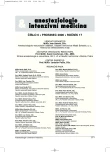TOF-Watch® SX vs. Datex-Ohmeda M-NMT: A comparison of the TOF-ratio measured with accelerometry or electromyography. A clinical, prospective, controlled study.
Authors:
M. Adamus 1; P. Adamus 2; R. Bělohlávek 3; M. Vujčíková 1; E. Janásková 1
Authors‘ workplace:
Klinika anesteziologie a resuscitace, Fakultní nemocnice a Lékařská fakulta Univerzity Palackého, Olomouc
1; Rapid System, s. r. o., Olomouc
2; Katedra informatiky, Přírodovědecká fakulta Univerzity Palackého, Olomouc
3
Published in:
Anest. intenziv. Med., 17, 2006, č. 6, s. 281-286
Category:
Anaesthesiology - Original Paper
Overview
Objective:
To compare the TOF-ratio measured with acceleromyography (ACC) and electromyography (EMG) during cis-atracurium or rocuronium-induced neuromuscular blockade. To determine the effectiveness of accelerometry for detection of a residual block.
Design:
Clinical, prospective, comparative, controlled study.
Setting:
Department of Anaesthesiology and Intensive Care, University Hospital.
Materials and Methods:
Following local ethics committee approval and obtaining informed consent, 47 patients scheduled for elective surgery under total intravenous anaesthesia with tracheal intubation and muscle relaxation were studied. In each consecutive patient, accelerometry (TOF-Watch® SX, Organon) and electromyography (Datex-Ohmeda) were used simultaneously to determine the TOF-ratio. Paired TOF-ratios were compared and bias, limits of agreement, sensitivity, specificity and validity for the accelerometric detection of the residual block were calculated.
Results:
1,505 paired measurements of TOF were obtained (TOFEMG and TOFACC). The average difference in the TOF-ratios showed a bias of –1.4% (SD 10.9). The limits of agreement (range in which 95% of the differences between paired measurements are expected to lie) were -23.3 to +20.5%. The sensitivity, specificity and validity of accelerometry to detect recovery from the neuromuscular block (TOFEMG ≥ 90%) were 47, 97 and 92% respectively. Both measurement techniques provided reliable information about the degree of neuromuscular block. Under the described study conditions accelerometry was able to detect residual neuromuscular blockade with acceptable precision.
Conclusion:
Accelerometry (TOF-Watch® SX) is a reliable clinical tool for the detection of a residual block but its results cannot be used interchangeably with electromyography (Datex-Ohmeda).
Key words:
neuromuscular blockade – electromyography – accelerometry – TOF-ratio
Labels
Anaesthesiology, Resuscitation and Inten Intensive Care MedicineArticle was published in
Anaesthesiology and Intensive Care Medicine

2006 Issue 6
Most read in this issue
- Physostigmine and its place in modern anaesthesiology and intensive care
- Flumazenil – a specific antagonist of the benzodiazepines at the beginning of the 21st century. Is it needed?
- Measurement of cardiac output by the pulse contour analysis (LiDCOTM plus) and the partial rebreathing of carbon dioxide (NICO) methods – a prospective comparative study
- TOF-Watch® SX vs. Datex-Ohmeda M-NMT: A comparison of the TOF-ratio measured with accelerometry or electromyography. A clinical, prospective, controlled study.
